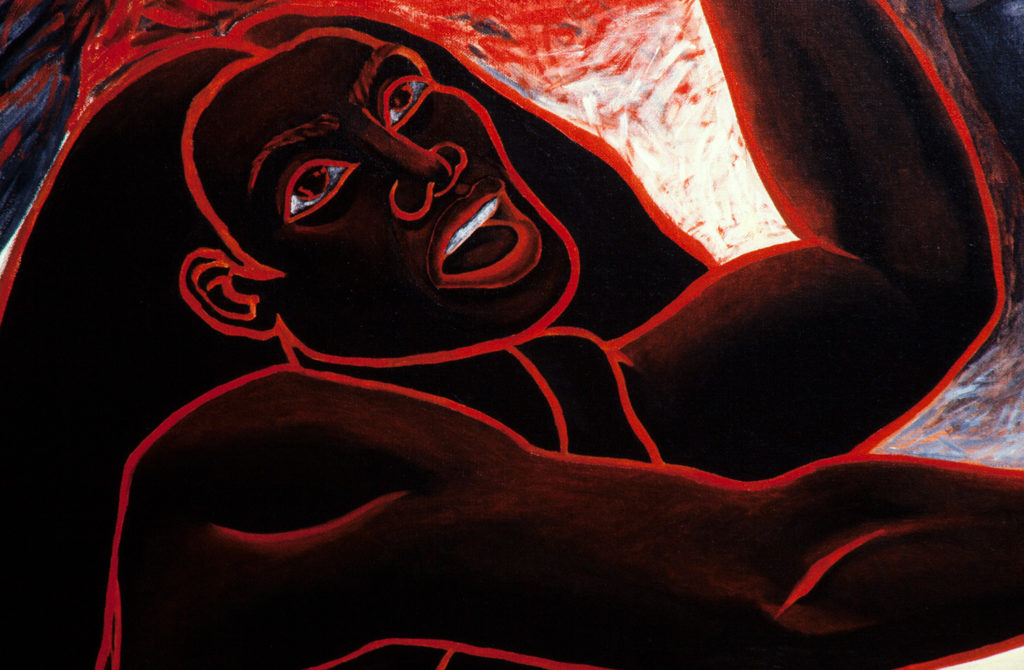ARTISTS Juliet Batten, Haeata (Tungia Baker, Ani Crawford, Hinemoa Hilliard, Robyn Kahukiwa, Rona Potiki, Irihapeti Ramsden, Rea Ropiha, Megan Tamati-Quennell), Robert Jahnke, Philip Kelly, Gerda Leenards, Robert Pouwhare, Diane Prince, Barbara Strathdee, Rob Taylor, Kura Te Waru-Rewiri PARTNERS Haeata, Project Waitangi OTHER VENUE Fisher Gallery, Auckland, 22 September—21 October 1990 PUBLICATION publisher Daphne Brasell Associates, Wellington; essays Irihapeti Ramsden, Paparangi Reid, Moana Jackson, Robert Pouwhare, Tony Simpson, Robert Jahnke, Gerda Leenards, Ray Ahipene-Mercer, Manuka Henare, Juliet Batten, Emele Duituturaga, Kathie Irwin, Kura Te Waru-Rewiri, Tony Whareaitu, Philip Kelly, Jenny Pattrick, Diane Prince, Pauline McKay, Robert Taylor, Edward Taihakurei Durie, Barbara Strathdee, Marion Wood, Haeata, City Gallery Wellington, Project Waitangi
1990 is the sesquicentennial of the signing of the Treaty of Waitangi and fifteen years after the passage of the Treaty of Waitangi Act. New Zealand museums mark the occasion through shows. Wellington City Art Gallery presents Mana Tiriti, a partnership between Haeata (a Wellington Māori women’s art collective), Project Waitangi (a national organisation aiming to educate Pākehā about the Treaty), and the Gallery. Haeata proposed the show, initially wanting six Pākehā and six Māori women to create personal responses to the Treaty, but the Gallery asked for it to be extended to women and men. Haeata select the Māori artists, Project Waitangi and the Gallery the Pākehā ones. In the Listener, Hugh Coley says this collaboration could have been a disaster but was a ‘curatorial triumph’.
The Māori artists are the Haeata collective, Robert Jahnke, Robert Pouwhare, Diane Prince, Paparangi Reid and Irihapeti Ramsden, and Kura Te Waru-Rewiri. Every artist in the Haeata collective contributes to Hineteiwaiwa te Whare. This whare wahine tells the story of the Maori women that signed the Treaty and acknowledges women’s role in ongoing debate around and implementation of Treaty promises. Paparangi Reid and Irihapeti Ramsden’s installation 150 Years of Dirty Laundry shows the Treaty and other historical documents in laundry baskets, hung on a washing line, and waiting to be ironed. Diane Prince creates Te Hono ki Waitangi Tent Embassy.
The Pākehā artists are Juliet Batten, Philip Kelly, Gerda Leenards, Barbara Strathdee, and Rob Taylor. Juliet Batten is concerned with the sacredness of the Treaty, with a focus on ritual and broken promises. Philip Kelly’s Treaty Time-Line takes a non-chronological approach to displaying key events, from the 1835 Declaration of Independence to 1990.
Mana Tiriti involves protest but also demonstrates Māori-Pākehā partnership. Nine forums featuring nationally recognised commentators on Treaty issues prove popular. Project Waitangi’s National Coordinator says there is standing room only most nights. Participants sit on whāriki (mats), loaned from Government House. A book is produced documenting the project, which includes an account of the process, the Governor General’s opening address, comments from the visitor books, transcriptions of forum discussions.




































































































































































































